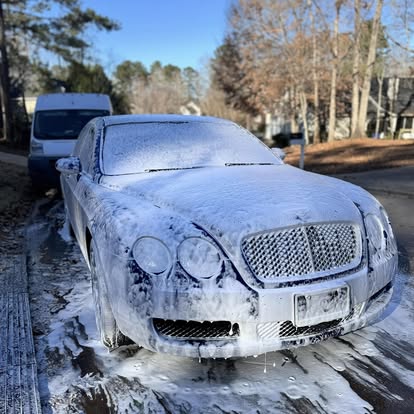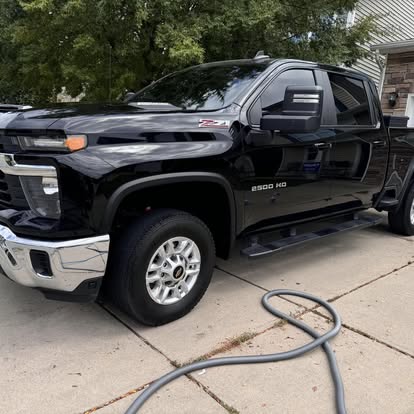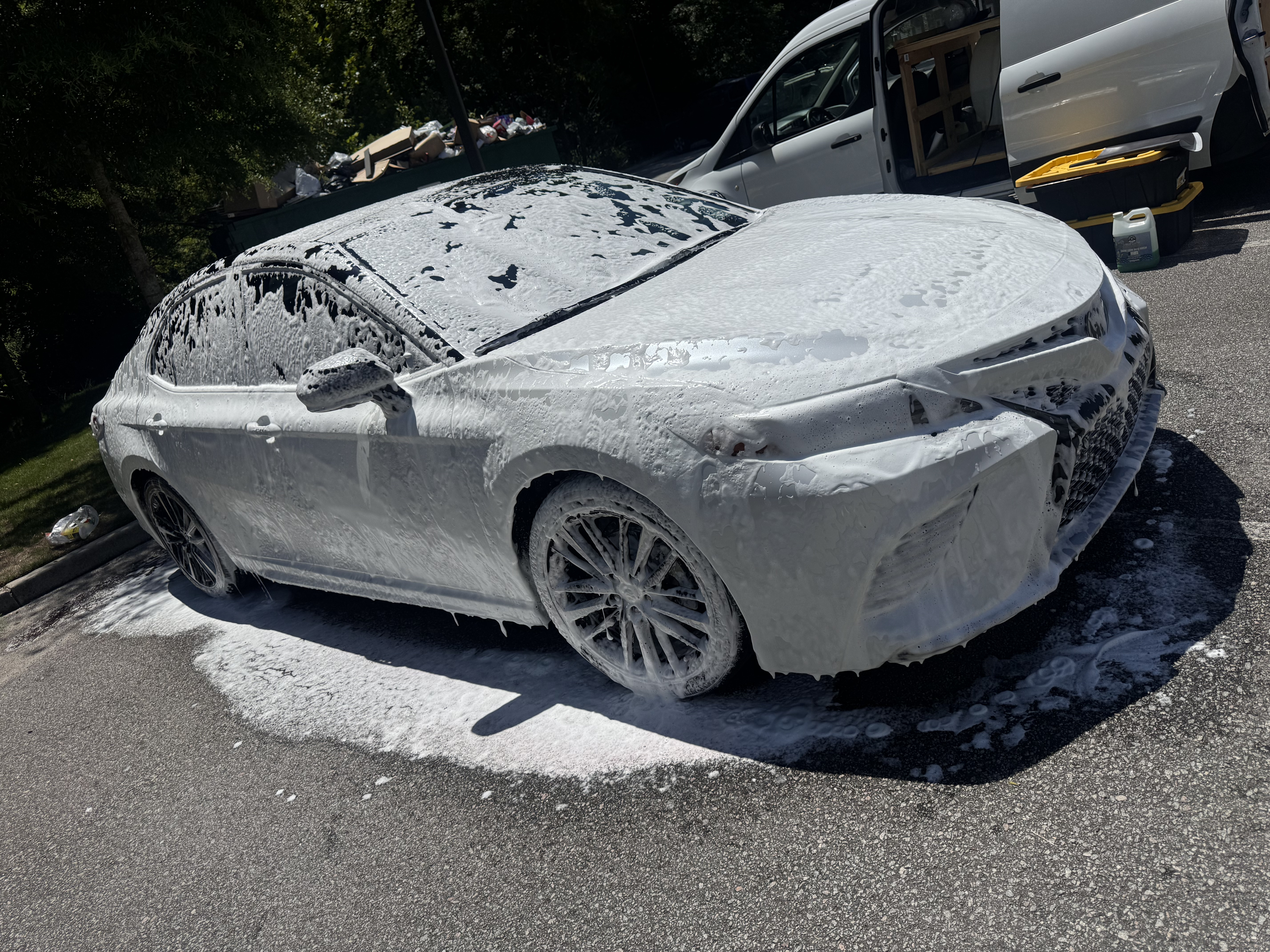Professional detailing transforms your vehicle, but maintaining those results between appointments maximizes your investment and extends the life of your detail. After training hundreds of Columbia customers in proper maintenance techniques, I've identified the simple routines that keep vehicles looking freshly detailed for months. This comprehensive guide provides practical, effective maintenance strategies specifically designed for South Carolina's challenging climate.
Understanding the Goal
Maintenance between professional details isn't about duplicating professional work—it's about preserving it. Think of professional detailing as deep cleaning and protection, while your maintenance is daily/weekly upkeep that prevents contamination buildup and preserves protection layers.
What maintenance can do:
- Extend time between professional details
- Preserve protection (wax, sealant, ceramic coating)
- Prevent bonded contamination
- Maintain fresh appearance
- Catch problems before they become permanent
What maintenance cannot do:
- Remove bonded contaminants (requires clay bar)
- Correct paint defects (requires polishing)
- Deep clean embedded dirt (requires extraction)
- Restore faded or damaged surfaces
Weekly Maintenance Routine (15-30 Minutes)
Exterior Quick Maintenance
Rinse-Off (Especially During Pollen Season)
Columbia's pollen season (March-May) requires weekly rinsing minimum:
Process:
- Rinse entire vehicle with hose or pressure washer
- Start at roof, work downward
- Focus on horizontal surfaces where pollen accumulates
- No soap needed—just remove loose pollen
- Dry with leaf blower or let air dry (if protected)
Why it matters: Pollen is acidic and etches paint when baked by sun. Daily accumulation during peak season can etch within 48 hours. Weekly rinsing prevents permanent damage.
Spot Cleaning Contaminants
Remove bird droppings, bug splatter, and tree sap immediately:
Process:
- Wet contaminated area thoroughly
- Spray with quick detailer or waterless wash product
- Let sit 30 seconds to soften
- Gently wipe with quality microfiber towel
- Never scrub or rub hard
Products to keep in vehicle:
- Quick detailer spray
- 3-4 clean microfiber towels
- Small spray bottle of water
Timeline: Remove within 24 hours. In South Carolina heat, bird droppings etch paint within hours if baked by sun.
Interior Quick Maintenance
Trash Removal
Seems obvious, but regular trash removal prevents:
- Odor development (especially food in heat)
- Stains from spilled drinks
- Attracting insects
- Creating clutter
Dashboard Dust Wipe
Quick wipe-down with microfiber cloth removes dust before it builds up. Takes 2 minutes and maintains fresh appearance.
Floor Mat Shake-Out
Remove mats weekly and shake out loose dirt. Prevents dirt from grinding into mat fibers and carpet underneath.
Bi-Weekly Maintenance Routine (60-90 Minutes)
Proper Hand Washing Technique
Washing every 1-2 weeks maintains protection and prevents contamination buildup. However, improper washing creates swirl marks that require professional correction. Follow this proven technique:
The Two-Bucket Method
Equipment needed:
- Two 5-gallon buckets
- Grit guards for both buckets
- Quality wash mitt (microfiber or sheepskin)
- pH-neutral car soap (never dish soap!)
- Multiple microfiber drying towels or leaf blower
- Wheel cleaning brush and separate mitt
Process:
Step 1: Preparation
- Park in shade (never wash in direct sun)
- Fill bucket #1 with clean rinse water + grit guard
- Fill bucket #2 with soap solution + grit guard
- Gather all supplies before starting
Step 2: Pre-Rinse
- Rinse entire vehicle with hose or pressure washer
- Remove loose dirt, pollen, debris
- Never touch paint before pre-rinsing
Step 3: Wheel Cleaning
- Clean wheels first (prevents brake dust contaminating clean paint)
- Use separate wheel mitt and cleaner
- Scrub wheel face and barrel
- Rinse thoroughly
Step 4: Paint Washing
- Start at roof, work downward in sections
- Dip mitt in soap bucket
- Wash one section using straight-line motions (not circles)
- Rinse mitt in clean water bucket
- Rub mitt against grit guard to release dirt
- Return to soap bucket and continue
- Rinse each section before moving to next
Step 5: Final Rinse
- Rinse entire vehicle thoroughly
- Use free-flowing water (remove nozzle) for sheeting action if protected
- Ensure all soap removed from crevices
Step 6: Drying
- Use plush microfiber drying towels or air blower
- Pat or gently drag—never circular rubbing
- Work top to bottom
- Dry door jambs, trunk, and hood edges
- Air dry option: leaf blower on low speed
Common Washing Mistakes to Avoid
- Using dish soap: Strips protection, dries out rubber and plastic
- Washing in direct sun: Soap dries too fast, causes water spots
- Circular washing motions: Creates swirl marks
- Using sponges: Trap dirt against paint, causing scratches
- Washing without pre-rinse: Drags dirt across paint
- Air drying without protection: Causes water spots in hard water
- Automated car washes: Brushes create thousands of swirl marks
Interior Maintenance
Thorough Vacuuming
Process:
- Remove floor mats and vacuum separately
- Vacuum carpets using back-and-forth pattern
- Use crevice tool for tight spaces
- Vacuum seats (cloth) including between cushions
- Vacuum trunk/cargo area
- Replace clean floor mats
Frequency: Bi-weekly minimum, weekly for families or pet owners.
Glass Cleaning
Products needed:
- Automotive glass cleaner (ammonia-free if tinted)
- Quality microfiber glass towels
Process:
- Spray cleaner on towel, not glass (prevents overspray)
- Wipe glass in one direction
- Flip towel and buff to clarity
- Clean interior glass last (prevents streaks)
Surface Wipe-Down
- Wipe dashboard, console, door panels with microfiber
- Clean steering wheel (daily contact = buildup)
- Wipe door handles and trim
- Use interior detailer spray for stubborn spots
Monthly Maintenance Tasks (2-3 Hours)
Protection Maintenance
For Waxed/Sealed Paint
If using traditional wax or sealant (not ceramic coating):
Quick detailer application:
- After washing and drying, mist quick detailer on paint
- Buff with clean microfiber towel
- Adds slickness between wax applications
- Enhances gloss and water beading
Reapply wax/sealant: Every 2-3 months in South Carolina climate (heat breaks down protection faster)
For Ceramic Coated Paint
Ceramic coating requires less maintenance but benefits from:
Ceramic boost spray:
- Use coating-specific maintenance spray monthly
- Enhances hydrophobic properties
- Adds slickness
- Maintains water beading
Never use: Traditional wax or polish on ceramic coating—these can reduce coating performance.
Wheel and Tire Maintenance
Deep Wheel Cleaning
Monthly deep cleaning prevents brake dust buildup:
- Use dedicated wheel cleaner (pH-appropriate for wheel type)
- Clean wheel barrels with specialized brushes
- Scrub thoroughly before rinsing
- Dry completely to prevent water spots
Tire Dressing Application
Quality tire dressing:
- Prevents dry-rot from UV exposure
- Maintains black appearance
- Protects against cracking
Application:
- Clean tires thoroughly first
- Apply dressing to applicator pad, not tire directly
- Spread evenly on sidewall
- Wipe off excess
- Let cure before driving
Avoid: Petroleum-based products that dry rubber in heat.
Interior Deep Cleaning
Dashboard and Trim Protection
South Carolina heat requires monthly UV protectant application:
Process:
- Clean surfaces first with interior cleaner
- Apply UV protectant to microfiber applicator
- Spread evenly on dashboard, console, door panels
- Buff to natural finish (not greasy)
Benefits:
- Prevents cracking from heat/UV
- Reduces fading
- Maintains flexibility
- Makes cleaning easier
Leather Conditioning (Summer Months)
Leather dries rapidly in Columbia heat:
Monthly conditioning June-September:
- Clean leather with pH-balanced cleaner first
- Apply conditioner with soft cloth
- Spread evenly across all leather surfaces
- Let absorb (usually 10-20 minutes)
- Buff off excess
Quarterly conditioning other months
Spot Treatment
Address new stains immediately:
- Blot (don't rub) liquid spills
- Use appropriate cleaner for stain type
- Test in inconspicuous area first
- Blot until stain lifts
- Allow to dry completely
Seasonal Maintenance
Post-Pollen Season (Late May)
- Thorough wash to remove all pollen residue
- Check for pollen etching
- Reapply protection if using wax/sealant
- Replace cabin air filter
Summer Prep (June)
- Verify protection integrity (water beading test)
- Extra leather conditioning
- Check tire pressure (increases with heat)
- Ensure windshield sunshade in vehicle
Fall Preparation (September)
- Remove summer bug buildup
- Prepare for leaf season
- Inspect weather stripping
- Deep clean before winter
Winter Maintenance (December-February)
- Immediate wash after coastal trips (salt exposure)
- Monitor for water spots from winter rain
- Interior cleaning after holiday travel
Product Recommendations for DIY Maintenance
Essential Products
Washing:
- pH-neutral car soap (Meguiar's Gold Class, Chemical Guys Mr. Pink)
- Two buckets with grit guards
- Quality wash mitt
- Multiple microfiber drying towels
Interior:
- Interior detailer spray (303 Aerospace, Meguiar's Interior Detailer)
- Glass cleaner ammonia-free (Invisible Glass, Stoner)
- Leather cleaner and conditioner (Lexol, Leather Honey)
- Assorted microfiber towels
Protection:
- Quick detailer (for waxed paint)
- Ceramic boost spray (for ceramic coated paint)
- UV protectant (303 Aerospace Protectant)
- Quality tire dressing (Meguiar's Endurance, CarPro DarkSide)
Products to Avoid
- Dish soap (strips protection)
- Household glass cleaner on tint (ammonia damage)
- Armor All and petroleum-based dressings
- Silicone-heavy products (attract dust)
- Automated car wash chemicals
Tools Worth Investing In
Priority Purchases
- Quality microfiber towels: $20-40 for variety pack
- Foam cannon (if you have pressure washer): $30-80
- Portable vacuum: $50-150
- Detailing brushes set: $15-30
- Leaf blower for drying: $50-150
Nice-to-Have Tools
- Dual-action polisher (for wax application, not correction): $150+
- Pressure washer: $150-400
- Steam cleaner: $100-300
When to Call the Professionals
Maintenance preserves professional detailing but doesn't replace it. Schedule [service-mobile-detailing] when:
- Paint feels rough despite washing
- Water no longer beads
- Visible swirl marks appear
- Stains you can't remove
- Odors develop
- 3-4 months since last professional detail
- Before/after pollen season
- Quarterly maintenance schedule
Maintenance Schedule Template
Weekly (15-30 min)
- Rinse exterior (pollen season)
- Spot clean contaminants
- Remove trash
- Dust dashboard
- Shake out floor mats
Bi-Weekly (60-90 min)
- Complete hand wash
- Interior vacuum
- Glass cleaning
- Surface wipe-down
Monthly (2-3 hours)
- Deep wheel cleaning
- Tire dressing
- Protection application/boost
- Interior UV protectant
- Leather conditioning (summer)
Quarterly (Professional Service)
- Complete professional detail
- Clay bar treatment
- Protection refresh/reapplication
- Deep interior extraction if needed
Maximizing Your Investment
Proper maintenance between professional details isn't just about appearance—it's about protecting your investment. Regular washing, interior care, and protection maintenance preserve the results of professional detailing while preventing damage that requires expensive correction.
For Columbia and Lexington vehicles facing South Carolina's challenging climate, diligent maintenance combined with quarterly [service-mobile-detailing] provides the perfect balance of DIY care and professional expertise. Your vehicle stays fresh, protected, and valuable year-round without breaking the bank on constant professional service.
Start implementing these maintenance routines today. Your vehicle—and your wallet—will thank you for years to come.


